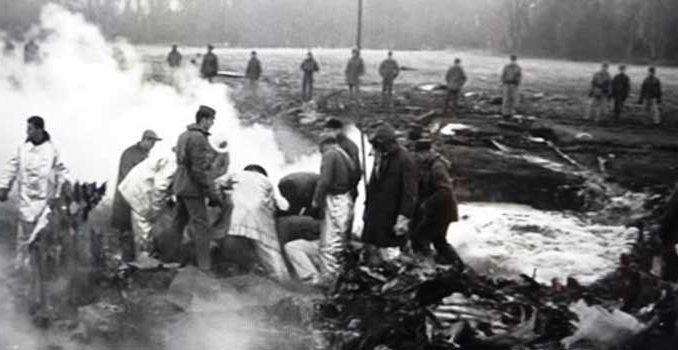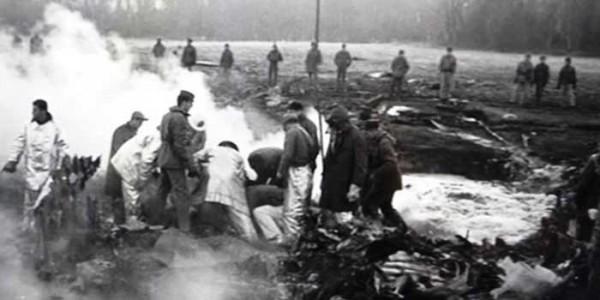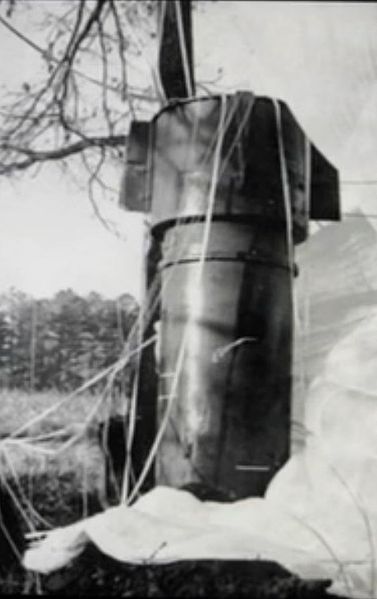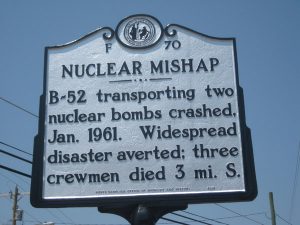

As reported on the online version of the British newspaper, The Guardian ,in 1961 the U.S. came close to a nuclear holocaust in North Carolina. Only a low voltage switch prevented a nuclear device, the hydrogen Mark 39 dropped by mistake,to exploded near Goldsboro, NC. Details were reveled by document obtained by investigative journalist Eric Schlosser on the basis of the Freedom of Information Act is published yesterday in The Guardian. The bomb would have been 260 times more powerful than the one that destroyed Hiroshima at the end of World War II.

RECONSTRUCTION – Accordingly to the Aviation Safety Network January 23rd 1961 a B-52G crashed and destroyed due to fatigue failure of starboard wing after fuel leak at high altitude. Wing failed when flaps were selected during emergency approach to Seymour Johnson AFB, Goldsboro, North Carolina, on January 24 1961.
Two nuclear weapons separated from the aircraft, one fell by parachute, and was caught by its parachute in the branches of a tree. The weapons came down at Faro, 12 miles (19 km) north of Goldsboro, North Carolina at approximate co-ordinates 35.5123°N 77.8463°W. One Mk.39 nuclear weapon crashed into the ground at approximately the speed of sound and buried its self deeply. The Air Force was unable to recover parts of the Mk.39 buried below about 40 feet due to flooding in the hole, so much of it was left in place. It was found that all but the last of four firing safeties had released on both bombs. Today, The Air Force still owns a 200 foot circle of ground in the field and occasionally tests for radiation
Here is a list The Buff’s crew:
Pilot: Maj Walter S Tulloch USAF ejected minor injuries.
Co-pilot: Capt Richard W Hardin USAF ejected minor injuries.
Rad/Nav: Maj Eugene Shelton USAF ejected killed.
Nav: Capt Paul E Brown USAF ejected minor injuries.
EWO: 1st/Lt William H Wilson USAF ejected serious injuries.
EWO/Inst: Maj Eugene H Richards USAF bailed out killed.
3rd pilot: 1st/Lt Adam C Mattocks USAF bailed out minor injuries.
AG: T/Sgt Francis R Barnish USAF killed.
700 OTHER ACCIDENTS SINCE 1950 – Schlosser came across the document during research for his book on the nuclear weapons called “Command and Control”. Taking advantage of the declassified documents , made possible by the Freedom of Information Act, he found out that at least 700 ‘significant’ incidents involving 1,250 nuclear weapons were recorded between 1950 and 1968.

On July 2, 2012, the state of North Carolina erected a historical road marker in the town of Eureka, 3 miles north of the crash site, commemorating the crash under the title “Nuclear Mishap.”, The unveiling ceremony was attended by Adam Mattocks, the sole survivor in 2012 of the crew of 58-0187.
For the actual declassified documents click HERE.


Be the first to comment
Graphic Design, Branding and Aviation Art